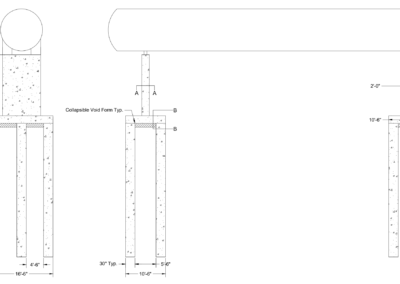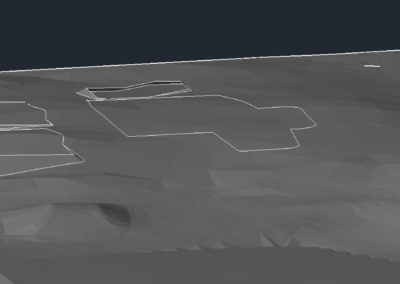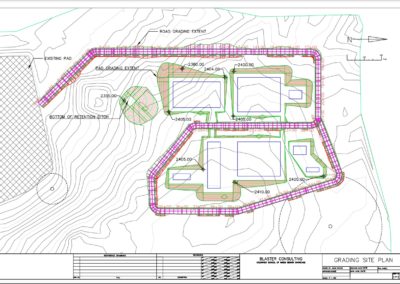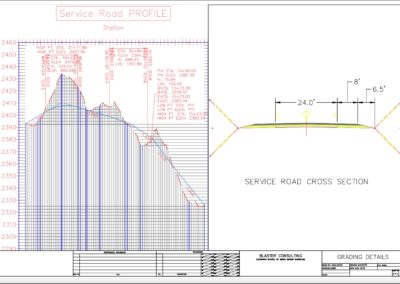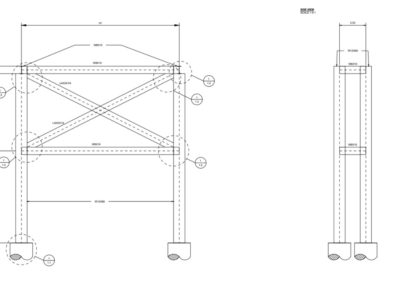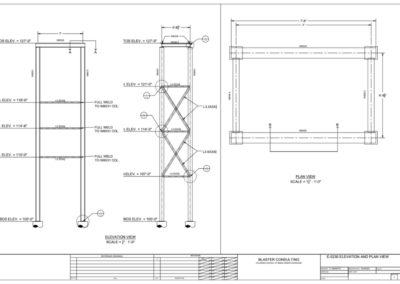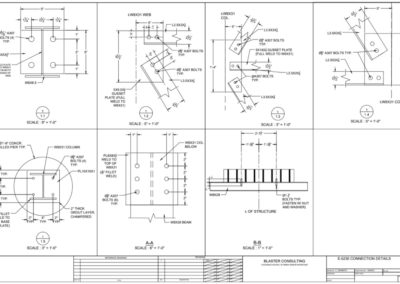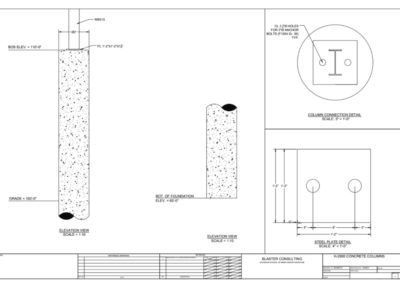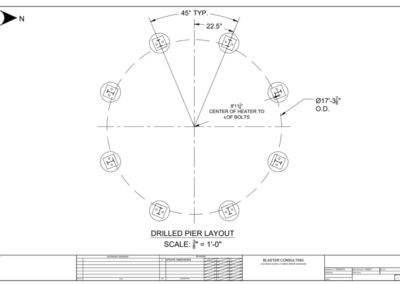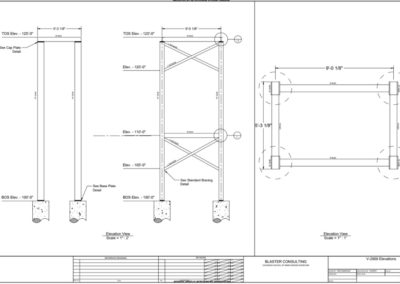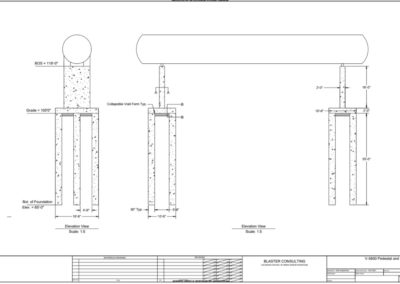Blaster Consulting – Gas Processing Facility Design
Overview
An existing oil and gas processing facility in North Dakota decided to expand their site with the addition of new oil and gas processing equipment. Paul Kuras, the client, asked the Blaster Consulting to provide full civil engineering services for this project. The project team was provided a proposed layout for the site, a geotechnical report of the area, and the drawings for the equipment to be added. The challenge for this project was to design the supporting structures and foundations for the six equipment, while also creating a grading and roadway design to accommodate the site expansion. An additional challenge was to design a hot oil system to supply the heat exchangers that will be added to the site. Final deliverables include a complete grading plan with cut and fill volumes, roadway design and sections, construction drawings for equipment structures and foundations, drawings and layouts for the added hot oil system, and all pertinent calculations and code references supporting the designs.

Live Zoom Chat
Use the link below to join us live from 8:00 – 10:30 a.m. on April 29th.
Meeting ID: 858 4642 0395
Passcode: 841419
One tap mobile
+13462487799,,85846420395#,,,,*841419# US (Houston)
+16465588656,,85846420395#,,,,*841419# US (New York)
Team Members
- Aiden Kistler
- Chris Okamoto
- Connor van Loveren
- Nick Kastenholz
- Talon Stanley
The Client
- Paul Kuras – Kahuna Ventures
Acknowledgements
We would like to thank Robin Steele, Dr. Hongyan Liu,and Dr. Marte Gutierrez for providing their guidance and technical expertise throughout the span of the project. We would lastly like to express our greatest appreciation to our client, Paul Kuras, for not only providing the opportunity to work on this unique project but also for his invaluable mentorship and assistance.
Video
Elevator Pitch
Energy that is cheap and available is one of the most important aspects of modern life; it is in many ways responsible for the great advances in quality of life since the industrial revolution. While many today like to focus on renewable energy, most people still depend on oil and gas to power their daily lives. The design of an oil and gas processing facility may not seem new or sexy or unique, but it is the sort of civil infrastructure project that allows society to function smoothly. The work done by Blaster Consulting serves just this purpose, it is a behind-the-scenes project that maintains the foundation of modern living.
Design Approach
After examining vendor drawings of the equipment and the geotechnical report of the site, the structural and foundation team began the design process by doing a load analysis per ASCE 7 and Process Industry Practices STC01015 Structural Design Criteria. Once this was completed, the team provided several options for the structural supports to the client for the Preliminary Design Review. The client elected to use reinforced concrete pedestals for the Air Cooler, Hot Oil Heater, and NGL Surge Drum, and braced steel frames for the Trim Reboiler, Gas Exchanger, and Hot Oil Expansion Tank. Per the geotechnical report and through performing a cost analysis, the recommendation was made to utilize drilled piers for the foundations at this site due to the presence of heaving clays and lignite. In the spring semester, the team began detailed structural and foundation calculations for the equipment. For reinforced concrete structures, initial designs were completed by hand per ACI 318-14 code and were later verified after modeling the structure in RISA-3D. An example structure can be seen in the gallery above. For steel frame structures, the design was completed and optimized in RISA-3D (seen to the right). For foundation design, hand calculations were completed to determine the required depth of the drilled piers based on skin friction and allowable bearing pressure. A horizontal deflection analysis was then performed in RISA-3D to ensure that the foundation didn’t deflect laterally more than 0.5” per the request of the client. Once all member sizing was complete, the team calculated connections details for the structures and drew the designs in AutoCAD to produce the final construction plan.
Grading design began with analyzing and understanding the geotechnical report, after which the site survey files were pulled into Civil 3D. The existing surface was created and evaluated. It was clear that the site had difficult topography and that the grading work would be substantial. The first part of grading looked at the development of pads on which to place the oil and gas processing equipment, which were designed to balance cut and fill. With the pads graded the focus then turned to the road design. The primary goal of this road was access to all the equipment. The road was designed and graded in Civil 3D using the corridor tools. After the road was designed, the team focused on drainage design and came to a combination of culverts around the road along with a retention basin to control the collection of runoff during storms and snow melts.
For the mechanical subsystem, the team started by defining the appropriate volume of fluid that needed to be transferred through reboiler E-5250 to achieve the required energy drop into the money flow. From there, lines were sized and designed per AMSE B31.30, with final decisions made based on cost analyses and with requests from the client. Pipe insulation was designed to protect from burns. Pumps and tanks were then sized using principles of fluid dynamics and based on project requirements.
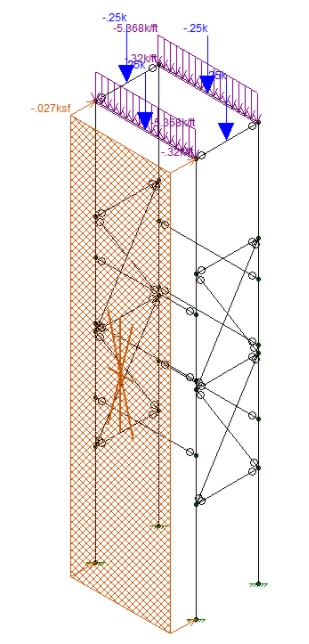
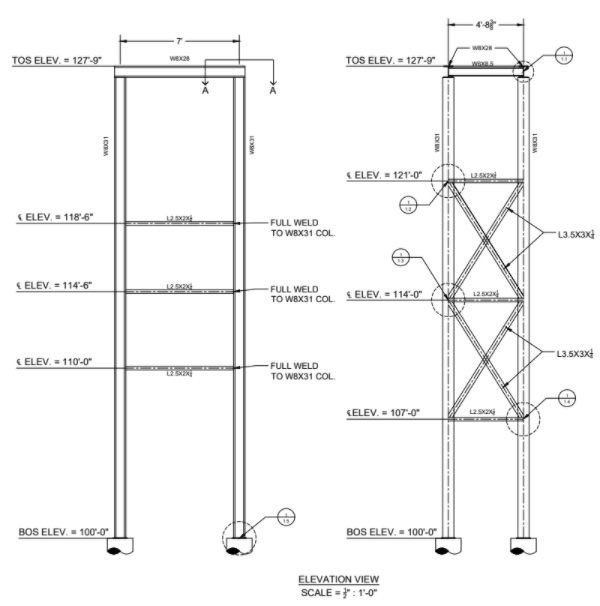
Design Solution
The goal for this project was to provide a complete set of construction drawings for site expansion alongside all required documentation and analysis verifying that the designs met code requirements. As the project team worked through the design process described above, the team consulted regularly with the client to ensure that the design met the client’s requirements and expectations. The final design report includes detailed documentation of the team’s design approach and methods, and the appendices include all detailed analyses and calculations necessary to show compliance with applicable building and process codes. In addition to the report, the client has been provided with complete construction drawings for all structures and foundations, a grading plan with roadway sections, and complete drawings of the hot oil pipe systems.
Details of the final structural and foundation design are too numerous to easily list here, but sample images have been included to show the scope of work. For the grading subsystem of the project, cut and fill balancing led to the development of 5 separate pads. Roads were designed to loop around all equipment and have a maximum slope of 6%, with a cross slope of 2%. The grading plan and a 3-D view of the pads may be seen in the photo gallery.
For the hot oil loop, the client chose a six-inch line size due to its cost-effectiveness. The team then selected schedule 40 seamless lines to meet pressures seen in the line, with two-inch cellular glass insulation for its ability to handle large temperature gradients. To drive the flow in the line, a pump was selected that could handle the 710 US gallons of flow with 34 bhp. Next, the expansion tank was sized to have a volume of 678 cubic feet and an inner diameter of six feet. The expansion will be elevated from the centerline of the rest of the loop by ten feet to ensure adequate suction pressure is seen by the pump. Finally, the hot oil heater was sized to be able to supply 18.7 MMBtu/hr to the flow in the loop.
Next Steps
Moving forward, the client had initially assigned the team 11 total oil and gas processing equipment at the very beginning of the project. Due to unforeseen circumstances, one team member had to take a leave of absence at the end of the fall semester. To accommodate the increased workload for the remaining team, the client reduced the number of equipment to the six that were described above. To complete the site expansion, the structures and foundations for the remaining five equipment can be designed. Apart from this, the designs and drawings are ready for construction and implementation pending proper approval from a Professional Engineer and local city officials.
Meet the Team
Aidan Kistler
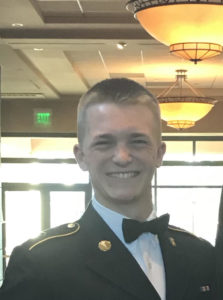 My name is Aidan Kistler and I am majoring in Civil Engineering with a focus in Construction engineering. I am originally from Ventura, California and grew up around the ocean and wanted to trade that in for the mountains of Colorado. I am a part of the Army ROTC program here at Mines, and I plan to commission as an active duty 2nd lieutenant in December 2021. Some of my interests outside of school and ROTC include mountain biking, snowboarding, hunting, and camping.
My name is Aidan Kistler and I am majoring in Civil Engineering with a focus in Construction engineering. I am originally from Ventura, California and grew up around the ocean and wanted to trade that in for the mountains of Colorado. I am a part of the Army ROTC program here at Mines, and I plan to commission as an active duty 2nd lieutenant in December 2021. Some of my interests outside of school and ROTC include mountain biking, snowboarding, hunting, and camping.
Chris Okamoto
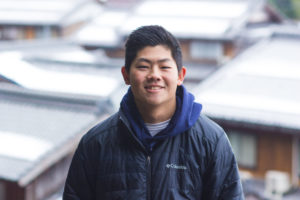 My name is Chris Okamoto and I am majoring in Civil Engineering with a focus in structural engineering. I was born in Tokyo, Japan but grew up in Salt Lake City, Utah. At Mines, I’m a member of the Mines varsity baseball team and serve as Community Outreach Co-Chair for the Student-Athlete Advisory Committee. Aside from baseball, I enjoy basketball, skiing, and hiking.
My name is Chris Okamoto and I am majoring in Civil Engineering with a focus in structural engineering. I was born in Tokyo, Japan but grew up in Salt Lake City, Utah. At Mines, I’m a member of the Mines varsity baseball team and serve as Community Outreach Co-Chair for the Student-Athlete Advisory Committee. Aside from baseball, I enjoy basketball, skiing, and hiking.
Connor van Loveren
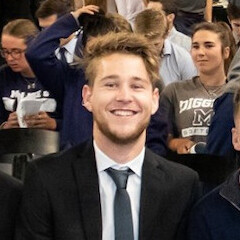 My name is Connor van Loveren, and I am from Utrecht, the Netherlands. I am a senior majoring in Civil Engineering with a double minor in Underground Construction & Tunneling and Economics. Besides devoting most of my time to the Senior Design project, where I am part of the Structures & Foundations team, I am also part of the Mines varsity soccer team.
My name is Connor van Loveren, and I am from Utrecht, the Netherlands. I am a senior majoring in Civil Engineering with a double minor in Underground Construction & Tunneling and Economics. Besides devoting most of my time to the Senior Design project, where I am part of the Structures & Foundations team, I am also part of the Mines varsity soccer team.
Nick Kastenholz
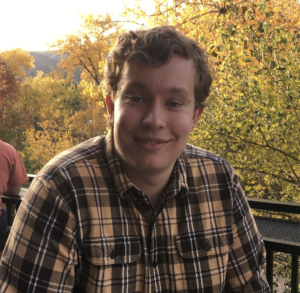 My name is Nick Kastenholz. I’m a civil engineering major studying structural and construction engineering. I’m originally from Chicago, Illinois, but I’ll be sticking around in Denver after graduation. Upon graduation, I’ll be working as a field engineer for a commercial contracting firm based in Denver. Outside of school and work, I enjoy spending time outside, hiking, hunting, and watching old movies.
My name is Nick Kastenholz. I’m a civil engineering major studying structural and construction engineering. I’m originally from Chicago, Illinois, but I’ll be sticking around in Denver after graduation. Upon graduation, I’ll be working as a field engineer for a commercial contracting firm based in Denver. Outside of school and work, I enjoy spending time outside, hiking, hunting, and watching old movies.
Talon Stanley
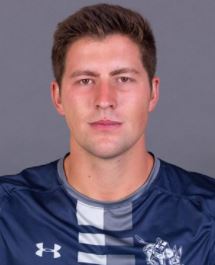 Hi, my name is Talon and I am majoring in Mechanical engineering with a minor in economics. I was born and raised in Anchorage, Alaska where I played soccer, backpacked, and fished in my free time. I was recruited to come play soccer at Colorado School of Mines for the 2017 fall season and have been with the program ever since. I will be graduating on May 14th, 2021.
Hi, my name is Talon and I am majoring in Mechanical engineering with a minor in economics. I was born and raised in Anchorage, Alaska where I played soccer, backpacked, and fished in my free time. I was recruited to come play soccer at Colorado School of Mines for the 2017 fall season and have been with the program ever since. I will be graduating on May 14th, 2021.

